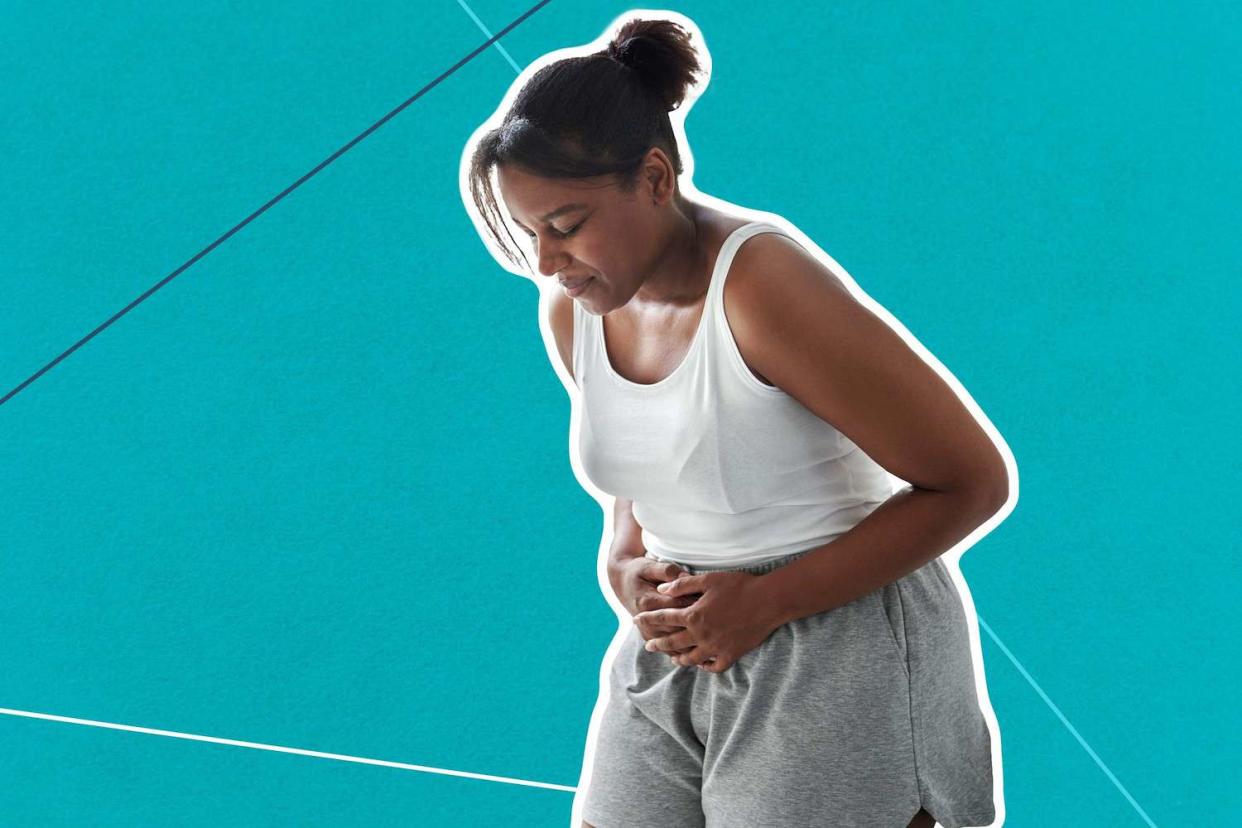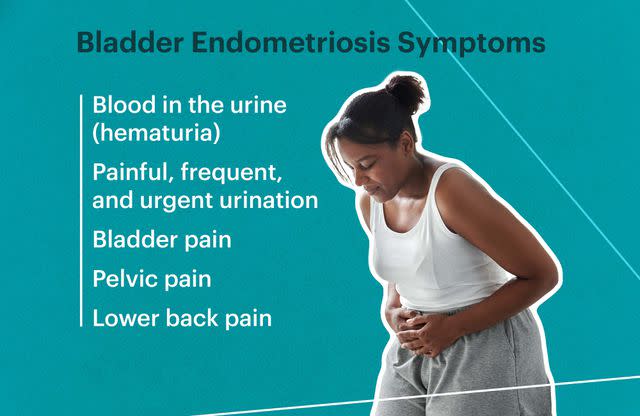Bladder Endometriosis and Painful Bladder Syndrome

Photo Illustration by Amelia Manley for Verywell Health; Getty Images
Medically reviewed by Monique Rainford, MDFact checked by Nick Blackmer
There are two main causes of bladder problems in endometriosis: endometrial tissue growths in or on the bladder (bladder endometriosis) and painful bladder syndrome (interstitial cystitis).
Painful bladder syndrome is sometimes called the “evil twin” of endometriosis because the conditions share symptoms and often occur together.
This article discusses both of these causes of bladder problems in endometriosis and how they are diagnosed and treated.

Photo Illustration by Amelia Manley for Verywell Health; Getty Images
Learn More: How Your Bladder Works
What Is Bladder Endometriosis?
Bladder endometriosis is where tissue that is similar to the uterine lining (endometrium) grows outside the uterus and in the bladder or on its surface.
These growths, also known as implants, typically begin with reproductive organs like the fallopian tubes and ovaries. Non-reproductive organs like the bladder and intestine can become affected as endometriosis spreads.
It’s possible to have bladder endometriosis without having endometrial tissue growth in other parts of your body, but it’s rare. People with bladder endometriosis often have lesions on their ovaries and the lining of the abdomen and/or pelvis. They may also have scarring (adhesions) that can cause organs to stick together.
Research estimates that only 0.3 to 12% of people with endometriosis have implants that affect their urinary system—what’s called urinary tract endometriosis (UTE). Bladder endometriosis is the most common type of UTE, occurring in about 85% of cases. The ureters are affected in about 10% of UTE cases.
Symptoms of Bladder Endometriosis
The symptoms of endometriosis depend on where the tissue grows. Specific symptoms caused by bladder endometriosis include:
Bladder pain
Lower back pain
Since the bladder, if affected, is typically only involved after lesions have developed in the reproductive organs, these symptoms can occur alongside classic symptoms including painful periods, pain during sex, fatigue, and infertility.
That said, bladder endometriosis sometimes causes no symptoms at all. Some people only learn they have it when they have a medical test for another reason (for example, because they are having trouble getting pregnant).
Learn More: The Most Common Symptoms of Endometriosis
How Bladder Endometriosis Is Diagnosed
If you have been diagnosed with endometriosis and have bladder or urinary tract symptoms that are not getting better with treatment, your provider might want to check you for bladder endometriosis.
Steps your provider might take to diagnose bladder endometriosis include:
Physical examination: Your provider will look at your vagina and bladder to check for endometriosis. They may also feel your lower belly to check your uterus and ovaries.
Ultrasound: Your provider can use this imaging test to look for signs of endometriosis on your bladder.
Magnetic resonance imaging (MRI): An MRI can be used to take pictures of your bladder and pelvis to see if there are any lesions.
Cystoscopy: Your provider may put a special scope with a camera into your urethra to look for endometriosis on your bladder.
Learn More: What Is a Transvaginal Ultrasound?
How Bladder Endometriosis Is Treated
The treatment for bladder endometriosis depends on how severe it is and what your symptoms are, but can include hormone medications and/or surgery.
Hormonal Treatments
Hormone medications like progestin/progesterone, oral contraceptives, and gonadotropin-releasing hormone (GnRH) agonists can be prescribed to reduce the growth of implants in/on the bladder.
Prescription medications such as Myfembree (relugolix, estradiol, and norethindrone acetate) can help treat pain associated with endometriosis. However, the use of Myfembree to treat endometriosis pain is limited to 24 months due to the risk of bone loss.
Learn More: Endometriosis Treatments: Medication, Surgery, and More
Surgery
If it’s possible to reach your implants during surgery, your provider may recommend a procedure to treat bladder endometriosis.
The different surgical options for treating bladder endometriosis include:
Open-surgery (laparotomy)
Partial cystectomy
Transurethral resection
Since it’s rare to only have endometrial lesions in or on the bladder, your surgeon will likely try to take out as many accessible lesions as they can during the surgery.
Learn More: What to Expect After Endometriosis Excision Surgery
What Is Painful Bladder Syndrome?
Painful bladder syndrome is also called interstitial cystitis (IC). It’s a chronic condition that can cause bladder symptoms in people with endometriosis.
Painful bladder syndrome is known as the “evil twin” endometriosis because their symptoms are very similar and they often occur together.
It’s possible to have one condition and not the other. But some peer-reviewed studies have found that about 65% of people with endometriosis have painful bladder syndrome as well.
Like endometriosis, the cause of painful bladder syndrome is unknown.
Learn More: Everything You Need To Know About Interstitial Cystitis
Symptoms of Painful Bladder Syndrome
Painful bladder syndrome causes constant pelvic pain, pressure, and discomfort in the bladder.
To be diagnosed with painful bladder syndrome, the bladder symptoms must be accompanied by at least one other urinary tract symptom that is not caused by an infection or another condition.
How Painful Bladder Syndrome Is Diagnosed
If you have symptoms of painful bladder syndrome, your provider will ask about your medical history and do a physical examination.
They may also do the following tests to rule out other causes of your pain:
Cystoscopy
Potassium sensitivity test (insertion of a solution into the bladder to see whether it causes pain)
Urinalysis (used to rule out other conditions like urinary tract infections)
In some cases, painful bladder syndrome is diagnosed when surgical treatment for endometriosis does not provide pelvic pain relief or when pelvic pain comes back soon after surgery.
How Painful Bladder Syndrome Is Treated
There are a few ways to treat painful bladder syndrome. You may need to use more than one strategy to control your symptoms.
Possible treatments for painful bladder syndrome symptoms include:
Lifestyle changes: Making some changes like reducing your alcohol and caffeine intake, quitting smoking, finding ways to manage stress, and engaging in regular physical activity may help you manage your symptoms.
Bladder training: Adjusting your urination schedule can, over time, help your bladder hold more urine before you have the urge to go.
Physical therapy (PT): You may need PT with someone who has experience in treating pelvic floor problems.
Over-the-counter (OTC) pain medication: Painkillers like Tylenol (acetaminophen) or Motrin (ibuprofen) may help with some pelvic and bladder pain.
Prescription medications: Your provider might recommend prescription medications like pentosan polysulfate (Elmiron), antihistamines, or tricyclic antidepressants such as amitriptyline to help with your symptoms.
Surgery: As a last resort, surgery can be done to expand the bladder, remove the bladder, or change the flow of urine.
It can take some time to find the best treatment. You’ll need to talk to your provider about the pros and cons of each option in your case.
For example, if you’re trying to get pregnant or want the option of having children, you’ll need to learn about how the treatments could affect your fertility.
Learn More: Bladder Training and Other Bladder Control Treatments
Summary
Endometriosis that affects your bladder can cause pain and other bladder symptoms. Endometriosis can also cause interstitial cystitis (IC), also known as painful bladder syndrome. The two have similar symptoms.
You’ll need to see a provider to get diagnosed with bladder endometriosis or painful bladder syndrome. They can do tests to figure out which condition is causing your pain and offer treatments that can help you manage your symptoms.
Learn More: Interstitial Cystitis With IBS

